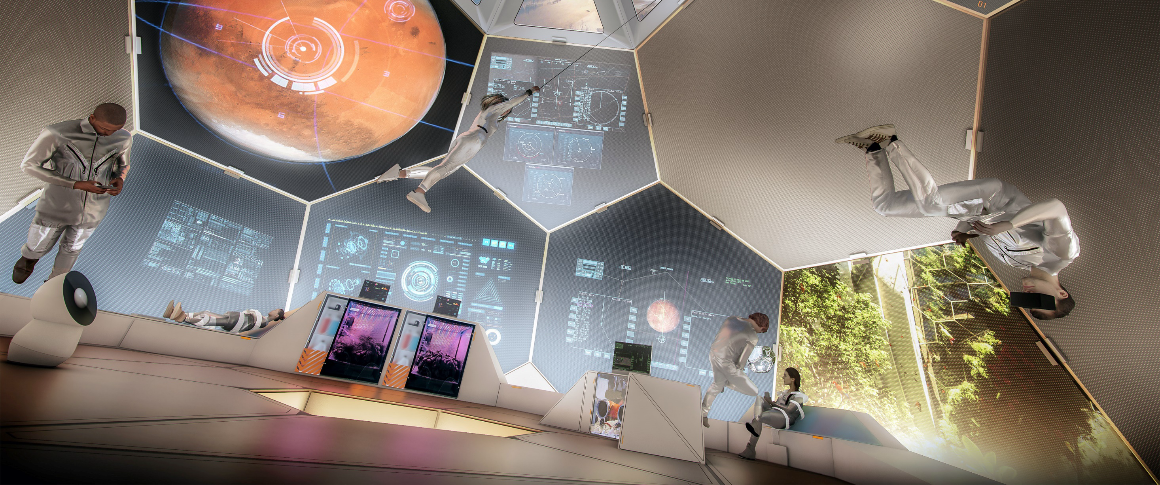Photo shows an artist rendering of a future space habitat built through a self-assembling, magnetic model—TESSERAE (Tessellated Electromagnetic Space Structures for the Exploration of Reconfigurable, Adaptive Environments). Courtesy of the Aurelia Institute.
In a rapidly changing profession, there are many issues for architects to keep pace with to protect the public, such as increasingly hostile environments resulting from climate change and the rise of artificial intelligence. As the opening speaker at NCARB’s inaugural Futures Symposium, Founder and Director of MIT's Space Exploration Initiative Dr. Ariel Ekblaw made the case that the expansion of the space industry should also be considered when it comes to opportunities to protect the public’s health, safety, and welfare. Dr. Ekblaw is also the founding CEO of Aurelia Institute a hybrid space architecture research institute and venture incubation studio.
Ariel Ekblaw says the burgeoning space industry aims to be not just for elite, highly-trained voyagers but for the everyday individual and that civilian space travel is on a path to becoming more accessible. And if that is true, architects—alongside engineers, experts in agriculture, and policymakers—will be needed to design a life that is worth living in space.
Why should space matter to architects?
At the heart of Dr. Ekblaw’s research is working to envision the products, tools, and experiences of society in space. At the same time, many question the relevance of a topic like space architecture while resources and energy are often lacking in the communities most affected by climate change here on Earth. But Dr. Ekblaw makes it clear that while Earth is our home—and the only planet where we biologically co-evolved—space offers opportunities for innovation and can actually help us solve problems we face on Earth.
She cites the International Space Station as an example, where today scientists are growing artificial retinas—which can only be made in space with microgravity—that could restore vision for people with macular degeneration. In other words, space can be a scientific laboratory for improving life on Earth.
What is the role of the architect in space?
Because space is no longer just for astronauts, Dr. Ekblaw asserts, we need architects and others in the architecture, engineering, and construction (AEC) industry to start designing space habitats and communities that are suited to supporting everyday life.
Architects know the influence of things like biophilia or how to design in a way that positively impacts individuals' mental health, said Dr. Ekblaw. It’s critical to think about the ways in which space structures give an opportunity for increased welfare (or do the opposite).
Architects are critical to thinking about welfare and understanding how to create environments where individuals can thrive in space, not just survive.
How should space architecture be regulated?
As we stride toward space exploration, striking a balance between innovation and regulation to protect human welfare is essential, said Dr. Ekblaw. Dr. Ekblaw advocates for guidelines rather than stringent regulations, proposing a well-studied menu of options for space architects, encouraging collaborative thinking while preserving creativity.
Though there are already some regulations in place for life in outer space (see: UN Committee on the Peaceful Use of Outer Space, the 1960 Outer Space Treaty), there is still a great opportunity for a multi-stakeholder community to establish guidelines for the welfare of those who venture beyond Earth.
Ethical concerns about life in space also loom large, from equitable access to space benefits to addressing ownership and rights issues. Dr. Ekblaw stresses the importance of sharing resources with emerging space-bearing nations and establishing ethical frameworks for human space life.
What can we learn from the past?
To create our future, Dr. Ekblaw believes learning from history, understanding what materials have worked in the past, and surveying user experiences are vital to creating a life worth living in space. Architects need to ask what worked for past space occupants, going beyond mission success and focusing also on questions of overall comfort, mental health, hygiene, and quality of life.
Rocket companies are already building the road to space. Now, it’s time to build out a life worth living once we get there.
Explore other cutting-edge conversations—such as architecture for extreme environments and the impact of the impact of artificial intelligence on the profession—led by speakers at NCARB's Future Symposium.
